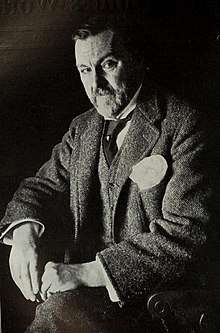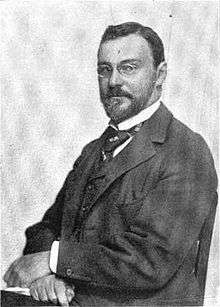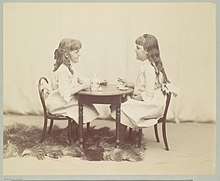Robert W. DeForest
Robert Weeks DeForest (1848–1931) was an American lawyer, financier, and philanthropist.
Robert W. DeForest | |
|---|---|
 Pictured in 1913 | |
| Born | April 25, 1848 New York City |
| Died | May 6, 1931 (aged 83) |
Early life
Robert Weeks DeForest was born to Henry Grant and Julia Mary Weeks DeForest in New York City on April 25, 1848, of French Huguenot ancestry. His grandfathers were the South Street merchant Lockwood DeForest and the New York Stock Exchange's first President, Robert D. Weeks. He attended primary school in New York City and Easthampton, Massachusetts, before graduating from Yale College with honors in 1870. DeForest received his law degree from Columbia University two years later and subsequently practiced law following admission to the Bar.[1]
Career

DeForest served as general counsel for the Central Railroad of New Jersey, and in 1902, became a vice president. He additionally served as the Hackensack Water Company's president for at least 15 years, and as a trustee or director of multiple other corporations.[1]
He also led public charity work. In 1901, President Theodore Roosevelt appointed DeForest to the State Tenement House Commission, which he served as chairman and which produced the Tenement House Law of 1901. It also led to the creation of a New York state Tenement House Department in 1902, following an amendment to the state charter. That year, DeForest was appointed New York City's first Tenement House Commissioner. He also served the New York State Conference of Charities and Corrections as well as the National Company of Charities and Corrections. In 1894, he co-founded and was the first president of the Provident Loan Society, which offered the poor lower interest loan alternatives to loan sharks. DeForest additionally served as a manager of NewYork–Presbyterian Hospital and the American Bible Society,[1] and dedicated 50 acres of his Long Island properties through West Hills and Dix Hills in rights of way to the state's Northern State Parkway project.[2]
.jpg)
DeForest served as a trustee of the Metropolitan Museum of Art in 1889,[1] and became its president in 1913, following J. P. Morgan.[3] The Museum later published a monograph by DeForest, Art in Merchandise: Notes on the Relationships of Stores and Museums, in 1928.[3]
Personal life

DeForest married Emily Johnson, the oldest daughter of Central Railroad of New Jersey President John Taylor Johnston, in 1872 and had four children.[1]
He belonged to organizations including the Century, University, Grolier, Jekyll Island, and Seawanhaka Yacht Clubs.[1]
DeForest's Wawapek Farm, a country house built in 1898 in Cold Spring Harbor and held by his descendants, was designed by Grosvenor Atterbury to follow the hill's curve in a comfortable American style distinct from the severe formality of European houses.[4]
References
- Cauldwell, William, ed. (July 1902). "Robert Weeks DeForest". The Successful American. 6 (1): 453. OCLC 665498862.
- "Gov. Smith Thanks DeForest for Land". The New York Times. May 7, 1928. ISSN 0362-4331.
- Belk, Russell W. (1995). Collecting in a Consumer Society. Psychology Press. p. 112. ISBN 978-0-415-10534-7.
- Toy, Vivian S. (October 20, 2002). "Four Centuries of Architectural Icons". The New York Times. ISSN 0362-4331.
Further reading
- "Robert W. de Forest, Civic Leader, Dies After Long Illness". The New York Times. May 7, 1931. pp. 1, 14. ISSN 0362-4331.
- "De Forest Will Gives $310,000 to Public". The New York Times. May 12, 1931. p. 25. ISSN 0362-4331.
- Walton, Andrea, ed. (2005). Women and Philanthropy in Education. Bloomington: Indiana University Press. ISBN 978-0-253-34466-3.CS1 maint: ref=harv (link)
External links
![]()